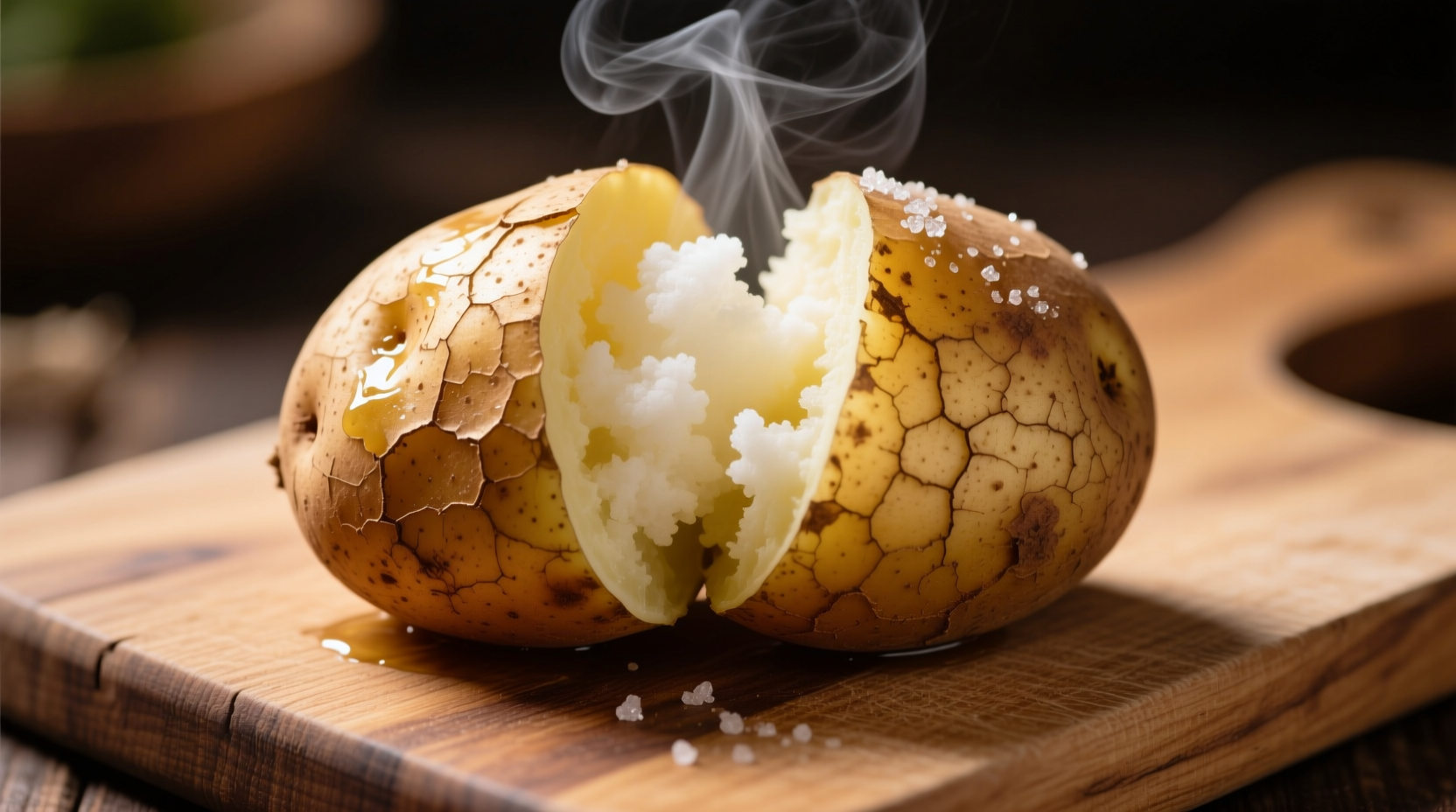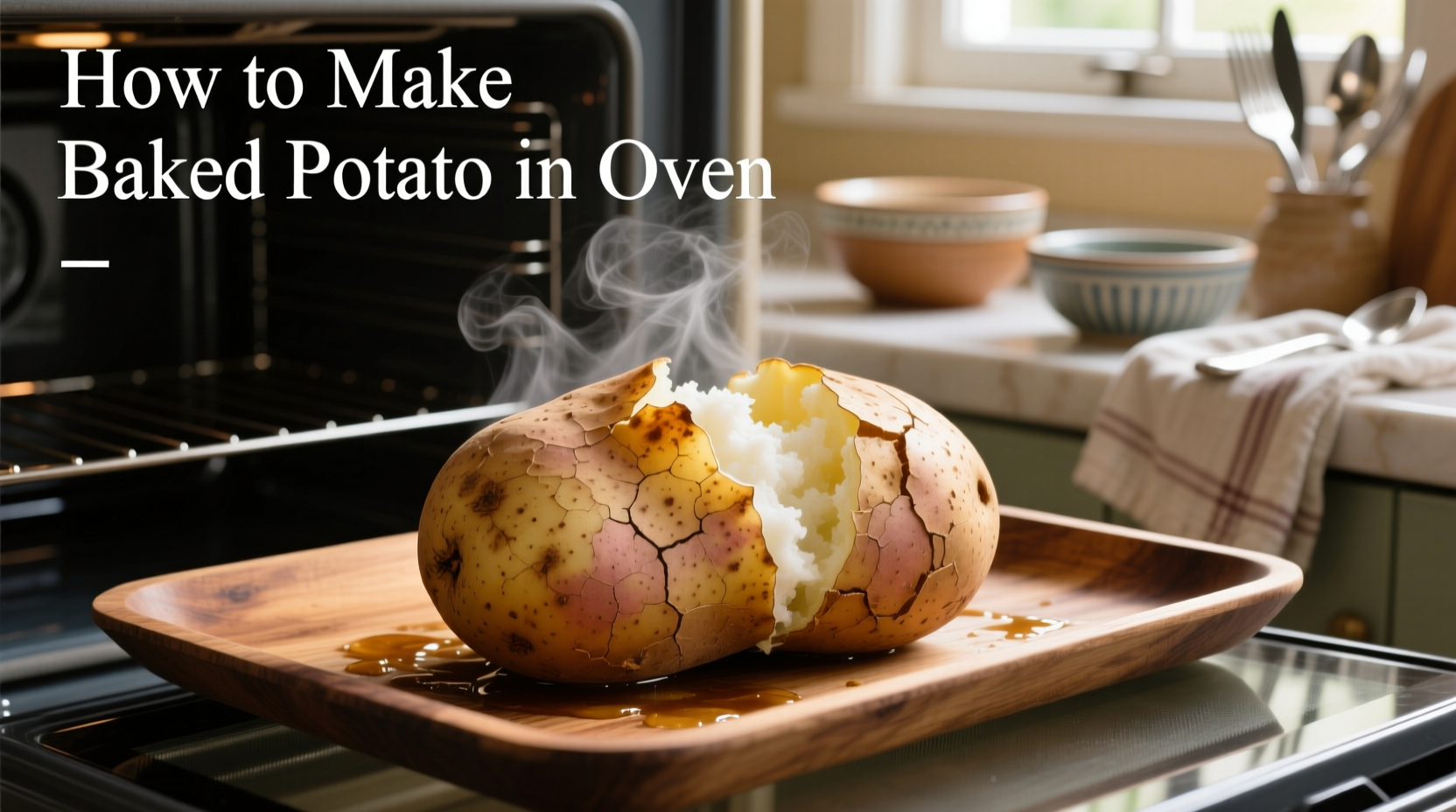Perfectly baked potatoes in 55-65 minutes at 400°F (204°C) with crispy skin and fluffy interior—no boiling required. This foolproof method works for russet, Yukon Gold, or sweet potatoes with simple seasoning and proper preparation techniques.
There's nothing quite like a perfectly baked potato—crisp skin giving way to fluffy, steaming interior that's ready for your favorite toppings. Forget soggy microwave versions or unevenly cooked store-bought options. This professional chef-tested method delivers consistent results every time, whether you're cooking one potato for a weeknight dinner or a dozen for a holiday gathering.
The Science Behind Perfect Baked Potatoes
Understanding the chemistry of potato baking transforms your results. Potatoes contain starch granules that absorb water and swell when heated. At 212°F (100°C), moisture inside the potato turns to steam, creating that desirable fluffy texture. The ideal baking temperature of 400°F (204°C) creates the perfect balance: hot enough to cook the interior thoroughly while crisping the exterior without burning.
| Potato Variety | Best For | Baking Time | Unique Characteristics |
|---|---|---|---|
| Russet (Idaho) | Classic baked potato | 55-65 minutes | High starch content creates fluffy interior |
| Yukon Gold | Creamier texture | 45-55 minutes | Naturally buttery flavor, thinner skin |
| Sweet Potato | Sweet applications | 60-75 minutes | Denser texture, caramelizes beautifully |
Step-by-Step Baking Process
Preparation: Setting Up for Success
Start with room-temperature potatoes—cold potatoes from the fridge create uneven cooking. Scrub thoroughly with a vegetable brush under cold water to remove dirt while preserving the skin's natural protective layer. Pat completely dry; moisture on the surface prevents crispiness.
Poke 4-6 deep holes with a fork to allow steam to escape—this prevents bursting in the oven. For extra-crispy skin, rub each potato with ½ teaspoon of olive oil and ¼ teaspoon of coarse salt. The oil helps conduct heat while the salt draws out moisture.
Baking: The Critical Cooking Phase
Place potatoes directly on the middle oven rack with a baking sheet on the lower rack to catch any drips. This allows hot air to circulate completely around each potato. For even cooking, rotate potatoes halfway through baking time.
Don't skip this professional trick: insert an instant-read thermometer into the thickest part of the potato. Perfect doneness occurs at 205-210°F (96-99°C). This precise measurement eliminates guesswork—undercooked potatoes feel dense while overcooked ones become dry.

Finishing: Unlocking Maximum Flavor
Remove potatoes from the oven and immediately slice a deep "X" across the top. Let them rest for 5 minutes—this allows residual heat to finish cooking the center while making the interior extra fluffy. Gently squeeze the base to open the potato without tearing the skin.
For restaurant-quality results, fluff the interior with a fork before adding toppings. This creates pockets for butter and seasonings to penetrate deeply rather than sitting on top. Add a pinch of flaky sea salt immediately after fluffing while the potato is still steaming.
Pro Tips for Perfect Results Every Time
Avoid Common Mistakes
Never wrap potatoes in foil—this steams rather than bakes them, resulting in soggy skin. Foil traps moisture that should evaporate for crispiness. If you must transport baked potatoes, use foil only after cooking to retain heat.
Don't overcrowd the oven. Potatoes need space for proper air circulation—minimum 1 inch between potatoes. Overcrowding creates steam pockets that prevent even cooking and crisp skin.
Flavor Variations Worth Trying
For garlic lovers, place a few whole garlic cloves in the oven alongside your potatoes. They'll roast gently and can be squeezed directly into the potato. Add fresh rosemary or thyme sprigs under the skin before baking for subtle herbal notes.
Sweet potato enthusiasts: brush with maple syrup during the last 10 minutes of baking for caramelized edges. Sprinkle with cinnamon and a pinch of cayenne for balanced sweet-heat complexity.
When This Method Works Best (And When to Choose Alternatives)
This traditional oven method excels when you want crispy skin and fluffy interior with minimal hands-on time. It's ideal for dinner preparations where oven space is available. However, consider alternatives in these specific contexts:
- Time-crunched situations: Use the microwave for 5-7 minutes to partially cook, then finish in a 450°F oven for 10-15 minutes for decent crispiness
- Large gatherings: For more than 8 potatoes, use two oven racks and rotate positions halfway through baking
- Crispiness priority: For maximum crunch, increase oven temperature to 425°F for the last 15 minutes of cooking
Troubleshooting Guide
Problem: Soggy skin
Solution: You likely didn't dry the potatoes thoroughly before baking or placed them on a baking sheet instead of directly on the rack. Next time, pat completely dry and place directly on oven rack with drip tray below.
Problem: Uneven cooking
Solution: Potatoes weren't rotated during baking or oven temperature was inconsistent. Rotate potatoes 180 degrees halfway through cooking and verify your oven temperature with an independent thermometer.
Problem: Hard center
Solution: Potatoes were too large or oven temperature too low. For potatoes over 10 ounces, increase baking time by 10-15 minutes or slice in half and bake cut-side down for the last 15 minutes.
Serving Suggestions That Elevate Your Baked Potato
Classic butter and sour cream never disappoint, but try these chef-inspired combinations:
- The Loaded Classic: Crispy bacon, sharp cheddar, chives, and a dollop of sour cream
- Mediterranean Twist: Feta cheese, kalamata olives, roasted red peppers, and a drizzle of olive oil
- Breakfast Style: Scrambled eggs, avocado, and everything bagel seasoning
- Healthy Option: Greek yogurt, steamed broccoli, and toasted pumpkin seeds
For optimal flavor distribution, mix toppings directly into the fluffed potato rather than layering on top. This creates uniform flavor in every bite rather than having toppings slide off.
Frequently Asked Questions
How long does it take to bake a potato at 400 degrees?
Russet potatoes take 55-65 minutes at 400°F (204°C). Smaller potatoes (under 8 ounces) may be done in 45-50 minutes, while larger ones (over 12 ounces) can require 70-75 minutes. The most reliable indicator is internal temperature—perfect doneness occurs at 205-210°F (96-99°C).
Should I poke holes in potatoes before baking?
Yes, always poke 4-6 deep holes with a fork before baking. This allows steam to escape during cooking, preventing potatoes from bursting in the oven. The holes should penetrate through the skin into the flesh for proper steam release.
Why isn't my baked potato fluffy inside?
Several factors affect fluffiness: undercooking (internal temperature below 205°F), using low-starch potatoes like red potatoes, or not letting potatoes rest for 5 minutes after baking. Russet potatoes provide the fluffiest results due to their high starch content. Proper fluffing technique—gently squeezing the base to open the potato—also creates the ideal texture.
Can I bake potatoes ahead of time and reheat them?
Yes, but with proper technique. Bake completely, then cool slightly before storing in the refrigerator for up to 3 days. To reheat, wrap in foil and bake at 350°F for 15-20 minutes until heated through. For best results, remove foil for the last 5 minutes to restore some crispiness. Avoid microwaving reheated potatoes as this makes skin rubbery.
What's the difference between baking russet and Yukon Gold potatoes?
Russet potatoes have thicker skin and higher starch content, creating the classic fluffy baked potato texture (55-65 minutes at 400°F). Yukon Golds have thinner skin and more moisture, resulting in a creamier texture with slightly shorter cooking time (45-55 minutes). Yukon Golds don't require oil for crispy skin since their natural moisture content is lower than russets.











 浙公网安备
33010002000092号
浙公网安备
33010002000092号 浙B2-20120091-4
浙B2-20120091-4